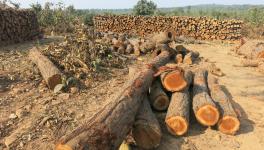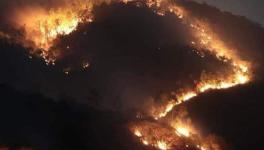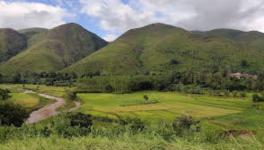Odisha: Similipal Fires Continue While Govt Claims Situation Under Control
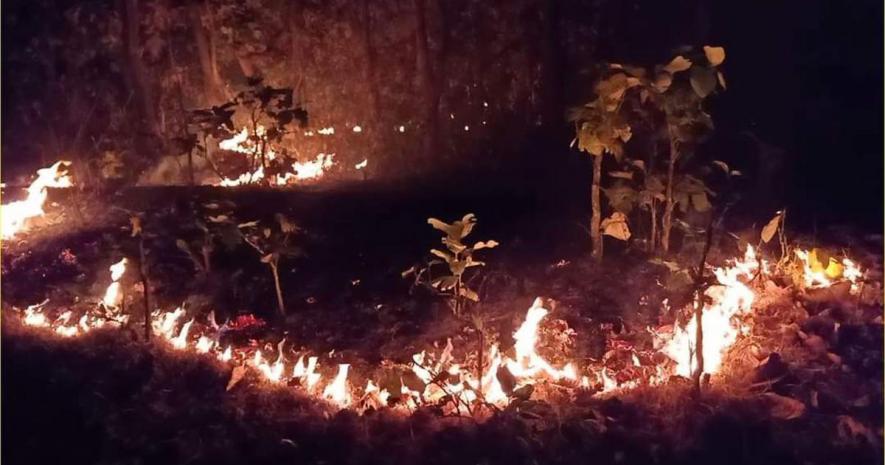
Image Courtesy: Twitter
India’s largest biosphere reserve, Similipal, located in the Mayurbhanj district of Odisha is currently witnessing enormous forest fires which have reportedly spread across multiple ranges for over 10 days. The reserve is home to over 300 species of birds, varieties of reptiles, fish among others, including the endangered Bengal tiger.
While Union Environment Minister Prakash Javadekar claims that the fires have been brought under control, satellite pictures of NASA's Fire Information for Resource Management System have showed that the fires continue to rage over Odisha and Similipal.
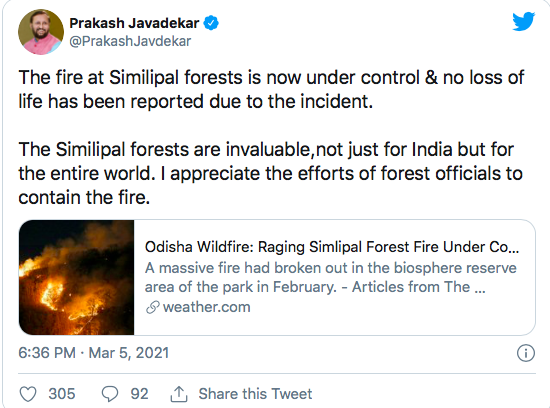
Talking about the extent of the forest fires, Aditya Panda, a wildlife conservationist based in Odisha, told NewsClick, “I'm on my way back from the interior hill districts of the state to the capital and there wasn't a single forest or hill during the 300 km journey that wasn't on fire.”
Similipal, which derives its name from ‘Simul’ (silk cotton) tree, spans over 5,569 sq km, and the area is inhabited and surrounded by adivasi population. The transition zone of the reserve has 1,200 villages with a total population of about 4.5 lakh. Tribals constitute about 73% of the population.
Reportedly, the fires began after local residents set fire to the dry leaves, which snowballed into the current crisis. Aditya Panda explained, “The fires are set off by the people for the harvest of mahua flowers and fruit, tendu leaves and for bushmeat poaching. The early onset of summer this year has started these practices sooner than usual. The Forest Department should have anticipated this and taken precautions well in time. There are set SOPs for fire prevention and a Rs 50 crore budget available for this."
Also read: Odisha: ‘Ease of Doing Business’ at Cost of Tribal Land and Livelihood
The local adivasi communities burn down the dry leaves in order to protect the mahua trees from moths and animals that attack the sweet fruit. Another reason, is that the fires help poachers who benefit from the animals running towards the outer areas away from the fires.
However, activists and researchers have said that simply putting the blame squarely on the adivasi communities dwelling in the area cannot absolve the state from taking its responsibility.
Biswajit Mohanty, secretary of the Wildlife Society of Odisha, writing for Down to Earth magazine pointed out, “It is now believed that the annual fire control budget for Odisha is Rs 50 crore. This includes temporary fire squads equipped with air blowers, vehicles and safety wire. A state-level toll free number can also be used to inform the administration of fire occurrences. Unfortunately, despite several requests by the writer, the number is publicised only through print or electronic media. Thereby, a majority of forest-dwelling communities remain unaware of the service.”
He added, “Several measures should be taken to control forest fires which involve community participation. Women NTFP collectors can be trained to sweep fallen leaves under mahua trees and burn them in a controlled manner, which will prevent the fire entering forest areas.”
Reiterating that the state needs to take up the responsibility, Sricharan Behra of the Centre for Survival and Dignity (CSD) said, “The forest fires in the area are not new. The adivasis living in the area are usually held responsible for the fires. While they are being blamed completely, the real issue is that the forest officials who should be preventing these fires are escaping their responsibility.”
“Instead of accusing those officials, the authorities are running behind the adivasi communities. Every year this happens, so the responsibility of the department needs to be questioned. As the soil dries up and the area becomes fire prone, there is a greater need to look into the bigger lacunae of the system, while involving the local adivasis in the preventive measures,” Behra added.
As the fire continues to engulf more areas, the focus is moving towards more involvement of the local communities in the preservation practices as well as sensitisation of the forest department towards indigenous practices. However, how far these measures will be implemented remains to be seen.
Also read: Forest Fires Tripled in Last Four Months, Says Forest Survey of India
Get the latest reports & analysis with people's perspective on Protests, movements & deep analytical videos, discussions of the current affairs in your Telegram app. Subscribe to NewsClick's Telegram channel & get Real-Time updates on stories, as they get published on our website.
















